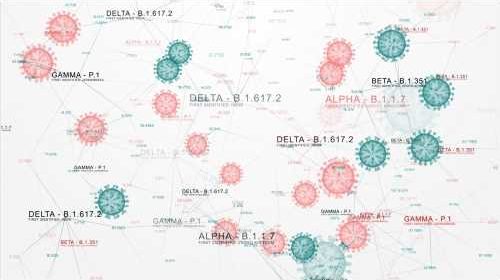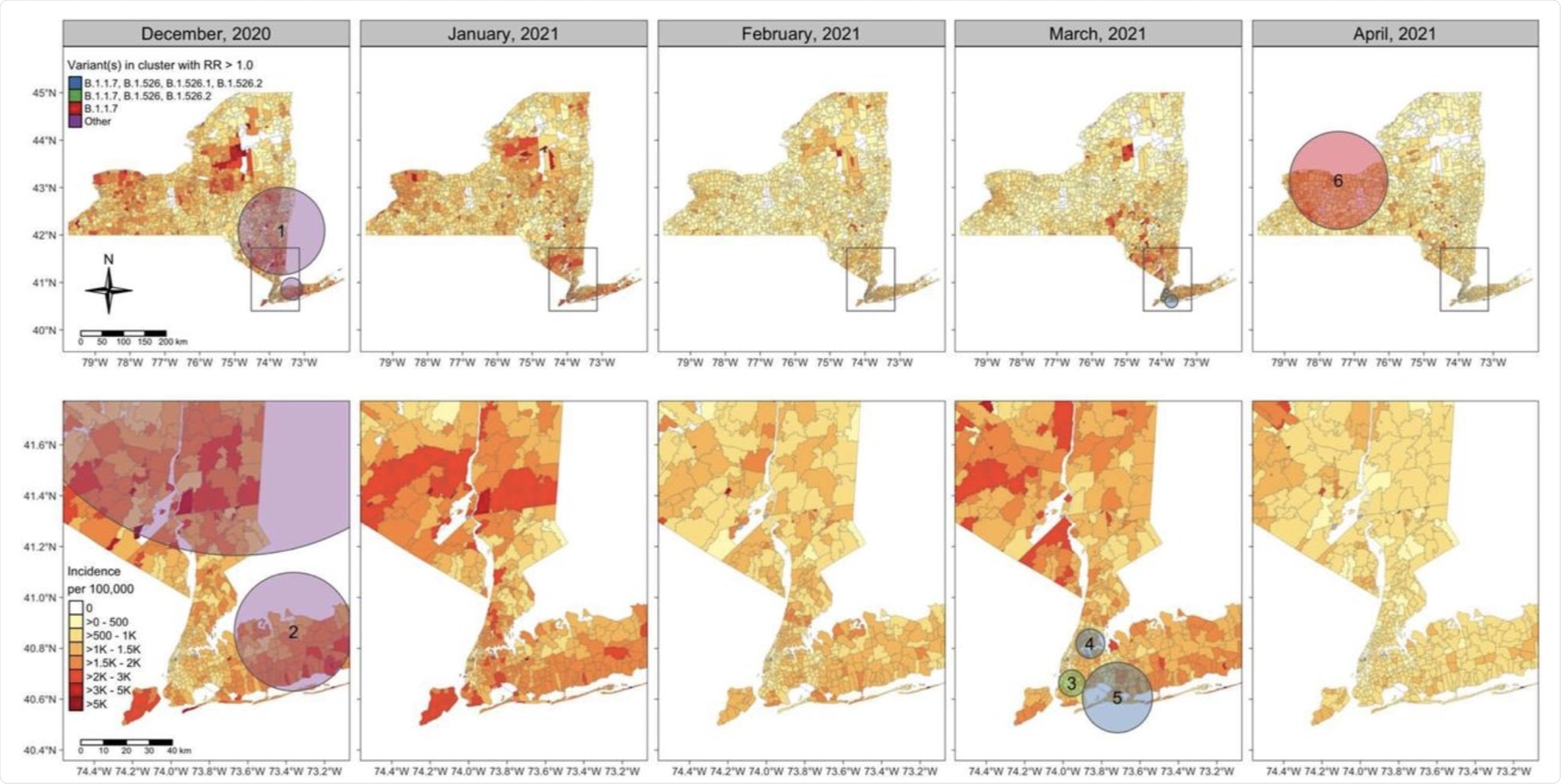New methodology for evaluating transmissibility and competitive advantages of co-circulating SARS-CoV-2 variants

As the severe acute respiratory syndrome coronavirus 2 (SARS-CoV-2)-triggered coronavirus disease 2019 (COVID-19) pandemic began to rage over the world, public health authorities recommended various non-pharmaceutical interventions (NPIs) to reduce viral transmission while vaccines and specific antiviral and antibody-based drugs were developed.
However, with the identification of newer SARS-CoV-2 variants within a year of the detection of the wild-type strain, it became clear that this outbreak would persist longer than initially expected. A new study published on the preprint server medRxiv* examines how these variants confer a competitive advantage on the virus, fueling further transmission and mortality.

Background
In the current study, the researchers explored how the SARS-CoV-2 Alpha (B.1.1.7) and Iota (B.1.526) variants circulated together in the New York area between December 2020 and April 2021. To this end, they used the data on virus strains by geographical location, the temporal and spatial spread of the virus, with map-based analysis.
The Alpha variant emerged in late 2020 and was found to exhibit significantly higher transmissibility and immune escape capabilities. This led to the declaration in December 2020 that the Alpha variant was a SARS-CoV-2 variant of concern (VOC).
The Alpha variant contains the N501Y mutation, which alters its immunodominant receptor-binding area (RBD) antigen and enables immune evasion, as well as enhancing spike-cell binding. Another mutation in this variant is the deletion del60-70, which is associated with higher infectivity.
The Iota variant likely emerged in the Bronx, New York late in 2020. It rapidly increased in prevalence locally, leading to its being declared a variant of interest (VOI). Like the Alpha variant, the Iota variant was also found to contain immune evasion mutations like spike E484K, which is also common to the Beta and Gamma VOCs. The E484K mutation has been shown to allow SARS-CoV-2 to escape neutralization by some monoclonal antibodies.
The S477N spike mutation is also found in approximately 30% of Iota sequences and is thought to have arisen independently at least twice. This mutation may make the strain more transmissible, as it affects the RBD. Nonetheless, this lineage was not linked to increased severity of disease, higher reinfection rates, or breakthrough infections.
Such data comes from the genomic surveillance of COVID-19. The current study used genomic data from the New York State Department of Health (NYSDOH) sequencing program to allow researchers to compare the transmissibility of these two variants.
Study findings
The study included approximately 8,500 SARS-CoV-2 sequences, comprising 6% of all new cases during the study period. The Alpha and Iota variants made up 13% and 10.6% of the total samples, respectively. The mean age of COVID-19 patients decreased overall, from 49.6 years in December 2020 to 46.5 years during the study.
From December 2020 to February 2021, the proportion of the Alpha strain remained below 15% in the Metro and Capital region. However, its prevalence began to increase in March 2021, which is when it reached 75% by the end of that month.
The prevalence of the Alpha strain continued to rise throughout April. However, this rise was slowest in the Metro region, where it made up 40% or less by this time point.
Conversely, the Iota variant was detected much earlier in December 2020 and increased in prevalence to 10% of Metro samples by the end of the month and 40% by the end of January 2021. Furthermore, by early March 2021, the Iota variant accounted for 60% of all new infections and continued to account for half of all samples through April 2021. Other regions saw a smaller proportion of under 40%, with the smallest rise in the Western region at under 15%.
Taken together, by the end of April 2021, the Alpha and Iota strains accounted for 80% of all new COVID-19 infections.
The researchers found that the Iota strain was able to establish itself in the city, with its dense network of interactions, whereby it spread to numerous places around the New York City region. The presence of this strain state-wide was delayed until March, with a low sustained proportion of infections that primarily remained within the Metro region.
Comparatively, the Alpha variant rose to prominence in upstate New York, where the proportion of infections caused by the Iota variant was low, thus indicating a limited capacity to compete with the latter. Nonetheless, the Alpha variant eventually spread through the southern part of the state and ultimately became prevalent state-wide by February 2021. In the New York City area, the Alpha variant became the dominant strain by April 2021, thus indicating the important role of the founder effect.

In other words, the Alpha variant was able to establish itself as an endemic coronavirus, even though the Iota variant was the more fit of the two. Initially, both viruses showed hotspots near the New York City metropolitan area.
However, while the Iota strain moved slowly northwest, the Alpha rapidly expanded into the upstate area of northwest New York in March and April 2021. The direction of spread changed from the southeast towards the northwest in April, thereby indicating the contribution of the extensive and rapid transmission of the Alpha variant in the Western part of the state.
Clusters of infection also showed a shift from non-Alpha and non-Iota variants to the Iota variant, and finally to the alpha variant between December 2020 to April 2021.
Implications
The current study provided information on the fluctuation in the incidence of COVID-19 state-wide, from a peak in December 2020 to January 2021, with a smaller peak from the end of March 2021 to early April 2021. This represents the first wave for most of the state and the second wave for New York City.
The spread of the initially dominant Iota variant was limited to New York City and its immediate surroundings by the numerous introductions of the Alpha variant, with its markedly higher transmissibility. The Alpha variant quickly became the dominant circulating strain in all regions where the Iota had not yet established itself, as observed in western New York in March-April 2021.
At the same time, the sustained dominance of the Iota variant in the Bronx as compared to many other regions indicates that even with its higher reproductive number, the Alpha variant found it more difficult to displace it as compared to other lineages circulating in these areas.
The current study demonstrates the value of using such analytical methods to compare the transmissibility and relative fitness of different variants of SARS-CoV-2 circulating in the same region at the same time. In this case, the VOI B.1.526 emerged in New York City, stunting the spread of the VOC B.1.1.7, which immediately became dominant in other parts of the city where the Iota had not obtained a foothold.
“Our research highlights the dynamics of inter-variant competition at a time when B.1.617.2 (Delta) is overtaking B.1.1.7 as the dominant lineage worldwide.”
Taken together, this work may help understand how SARS-CoV-2 variants interact with each other against a background of newer and fitter strains.
*Important notice
medRxiv publishes preliminary scientific reports that are not peer-reviewed and, therefore, should not be regarded as conclusive, guide clinical practice/health-related behavior, or treated as established information
- Russell, A., O’Connor, C., Lasek-Nesselquist, E., et al. (2021). Spatiotemporal Analyses Illuminate the Competitive Advantage of A SARS-Cov-2 Variant of Concern Over a Variant of Interest. medRxiv. doi:10.1101/2021.09.14.21262977. https://www.medrxiv.org/content/10.1101/2021.09.14.21262977v1
Posted in: Medical Science News | Medical Research News | Disease/Infection News
Tags: Antibodies, Antibody, Antigen, Cell, Coronavirus, Coronavirus Disease COVID-19, Drugs, Genomic, Mortality, Mutation, Pandemic, Public Health, Receptor, Research, Respiratory, SARS, SARS-CoV-2, Severe Acute Respiratory, Severe Acute Respiratory Syndrome, Syndrome, Virus

Written by
Dr. Liji Thomas
Dr. Liji Thomas is an OB-GYN, who graduated from the Government Medical College, University of Calicut, Kerala, in 2001. Liji practiced as a full-time consultant in obstetrics/gynecology in a private hospital for a few years following her graduation. She has counseled hundreds of patients facing issues from pregnancy-related problems and infertility, and has been in charge of over 2,000 deliveries, striving always to achieve a normal delivery rather than operative.
Source: Read Full Article